2017 FIAT 500 ABARTH CABRIO child seat
[x] Cancel search: child seatPage 35 of 338
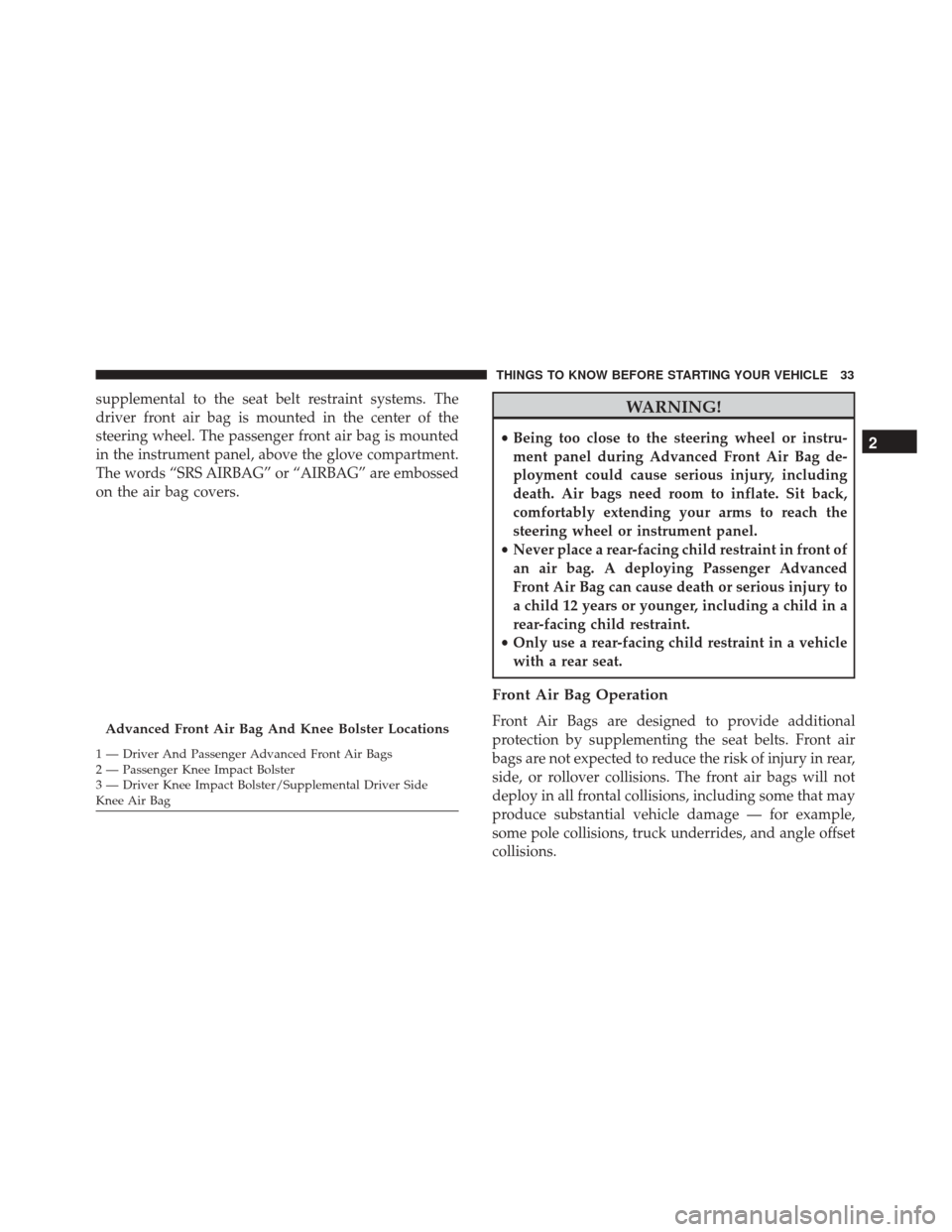
supplemental to the seat belt restraint systems. The
driver front air bag is mounted in the center of the
steering wheel. The passenger front air bag is mounted
in the instrument panel, above the glove compartment.
The words “SRS AIRBAG” or “AIRBAG” are embossed
on the air bag covers.WARNING!
•Being too close to the steering wheel or instru-
ment panel during Advanced Front Air Bag de-
ployment could cause serious injury, including
death. Air bags need room to inflate. Sit back,
comfortably extending your arms to reach the
steering wheel or instrument panel.
• Never place a rear-facing child restraint in front of
an air bag. A deploying Passenger Advanced
Front Air Bag can cause death or serious injury to
a child 12 years or younger, including a child in a
rear-facing child restraint.
• Only use a rear-facing child restraint in a vehicle
with a rear seat.
Front Air Bag Operation
Front Air Bags are designed to provide additional
protection by supplementing the seat belts. Front air
bags are not expected to reduce the risk of injury in rear,
side, or rollover collisions. The front air bags will not
deploy in all frontal collisions, including some that may
produce substantial vehicle damage — for example,
some pole collisions, truck underrides, and angle offset
collisions.Advanced Front Air Bag And Knee Bolster Locations
1 — Driver And Passenger Advanced Front Air Bags
2 — Passenger Knee Impact Bolster
3 — Driver Knee Impact Bolster/Supplemental Driver Side
Knee Air Bag
2
THINGS TO KNOW BEFORE STARTING YOUR VEHICLE 33
Page 37 of 338
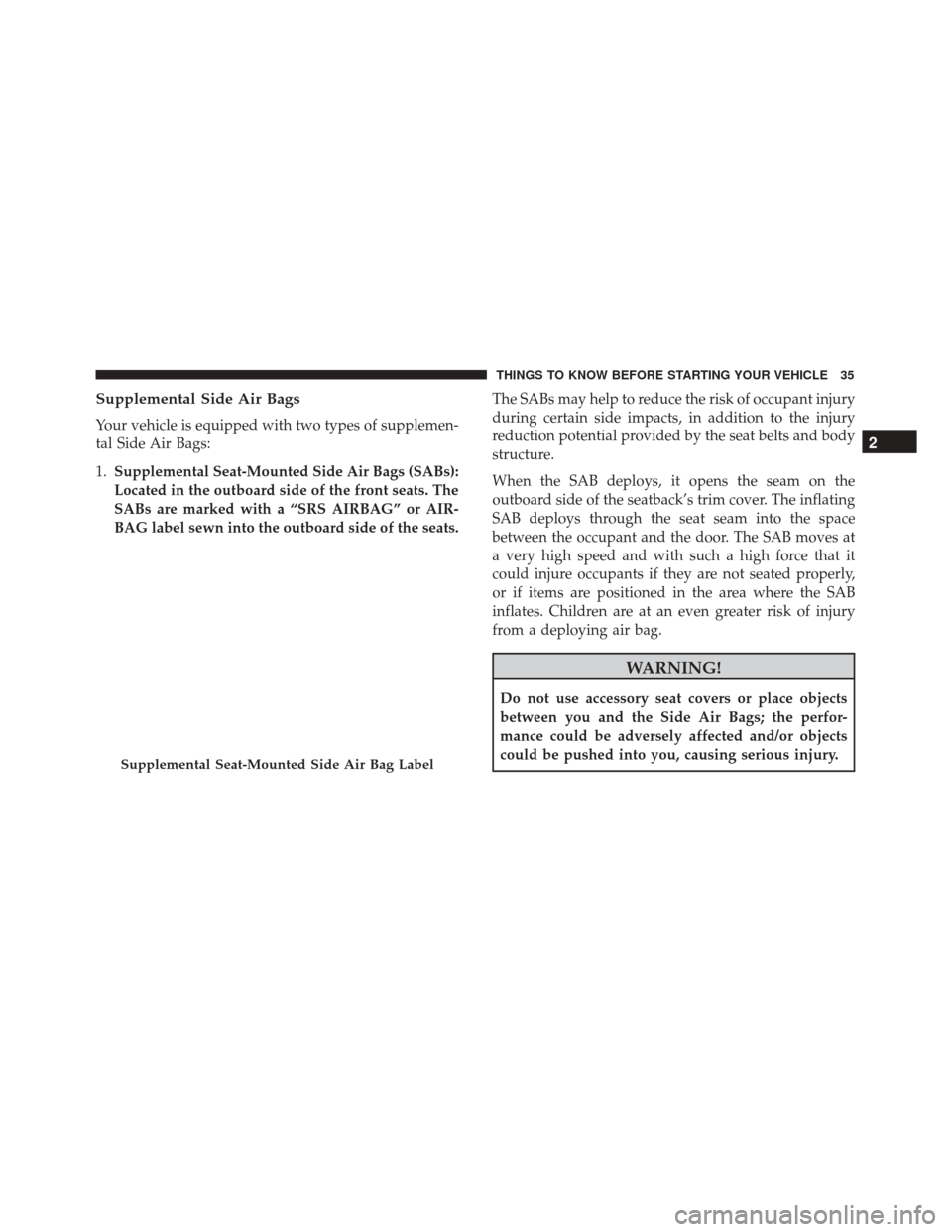
Supplemental Side Air Bags
Your vehicle is equipped with two types of supplemen-
tal Side Air Bags:
1.Supplemental Seat-Mounted Side Air Bags (SABs):
Located in the outboard side of the front seats. The
SABs are marked with a “SRS AIRBAG” or AIR-
BAG label sewn into the outboard side of the seats. The SABs may help to reduce the risk of occupant injury
during certain side impacts, in addition to the injury
reduction potential provided by the seat belts and body
structure.
When the SAB deploys, it opens the seam on the
outboard side of the seatback’s trim cover. The inflating
SAB deploys through the seat seam into the space
between the occupant and the door. The SAB moves at
a very high speed and with such a high force that it
could injure occupants if they are not seated properly,
or if items are positioned in the area where the SAB
inflates. Children are at an even greater risk of injury
from a deploying air bag.
WARNING!
Do not use accessory seat covers or place objects
between you and the Side Air Bags; the perfor-
mance could be adversely affected and/or objects
could be pushed into you, causing serious injury.
Supplemental Seat-Mounted Side Air Bag Label
2
THINGS TO KNOW BEFORE STARTING YOUR VEHICLE 35
Page 38 of 338
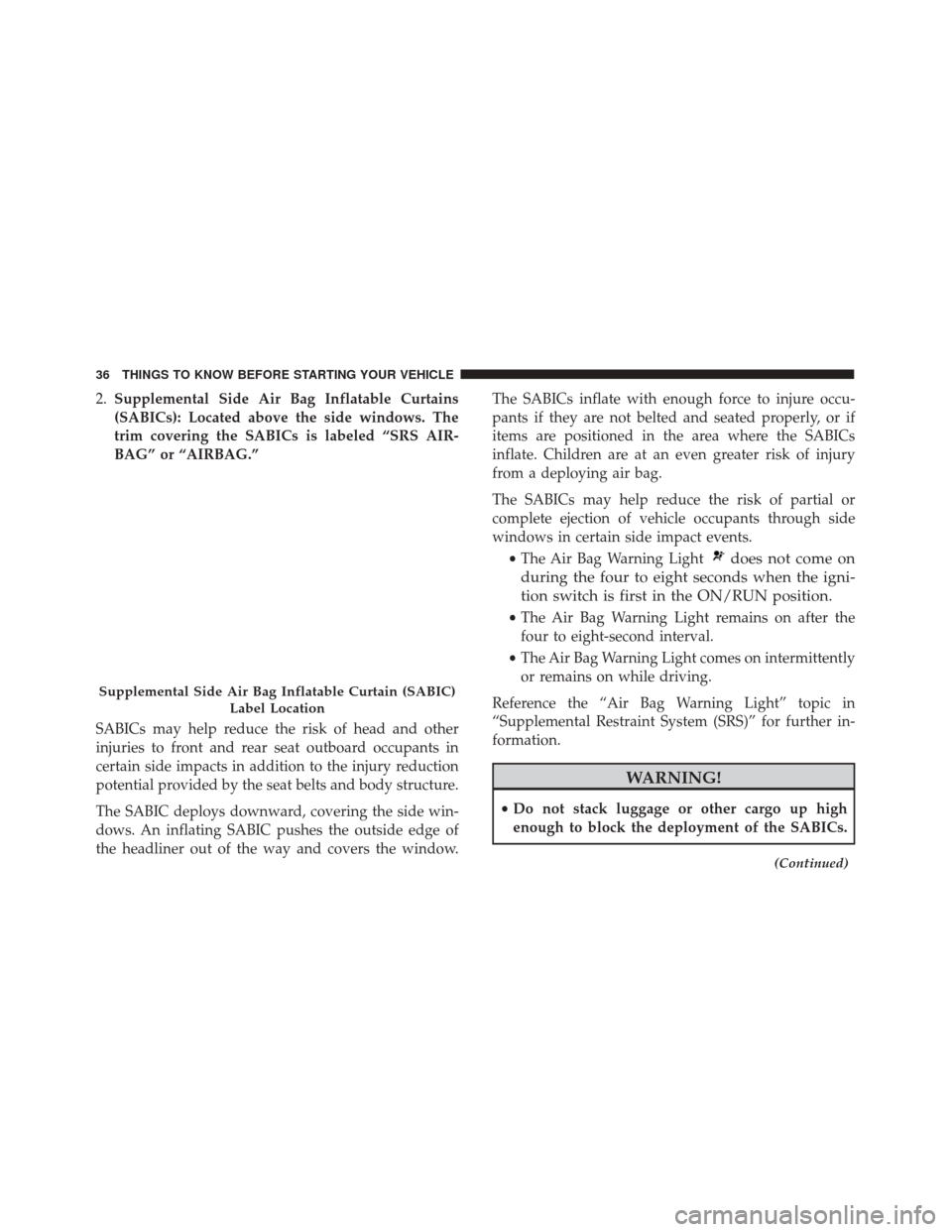
2.Supplemental Side Air Bag Inflatable Curtains
(SABICs): Located above the side windows. The
trim covering the SABICs is labeled “SRS AIR-
BAG” or “AIRBAG.”
SABICs may help reduce the risk of head and other
injuries to front and rear seat outboard occupants in
certain side impacts in addition to the injury reduction
potential provided by the seat belts and body structure.
The SABIC deploys downward, covering the side win-
dows. An inflating SABIC pushes the outside edge of
the headliner out of the way and covers the window. The SABICs inflate with enough force to injure occu-
pants if they are not belted and seated properly, or if
items are positioned in the area where the SABICs
inflate. Children are at an even greater risk of injury
from a deploying air bag.
The SABICs may help reduce the risk of partial or
complete ejection of vehicle occupants through side
windows in certain side impact events.
•The Air Bag Warning Light
does not come on
during the four to eight seconds when the igni-
tion switch is first in the ON/RUN position.
• The Air Bag Warning Light remains on after the
four to eight-second interval.
• The Air Bag Warning Light comes on intermittently
or remains on while driving.
Reference the “Air Bag Warning Light” topic in
“Supplemental Restraint System (SRS)” for further in-
formation.
WARNING!
• Do not stack luggage or other cargo up high
enough to block the deployment of the SABICs.
(Continued)
Supplemental Side Air Bag Inflatable Curtain (SABIC)
Label Location
36 THINGS TO KNOW BEFORE STARTING YOUR VEHICLE
Page 39 of 338

WARNING!(Continued)
The trim covering above the side windows where
the SABIC and its deployment path are located
should remain free from any obstructions.
• In order for the SABICs to work as intended, do
not install any accessory items in your vehicle
which could alter the roof. Do not add an after-
market sunroof to your vehicle. Do not add roof
racks that require permanent attachments (bolts
or screws) for installation on the vehicle roof. Do
not drill into the roof of the vehicle for any
reason.
The SABICs and SABs (“Side Air Bags”) are designed to
activate in certain side impacts. The Occupant Restraint
Controller (“ORC”) determines whether the deploy-
ment of the Side Air Bags in a particular impact event is
appropriate, based on the severity and type of collision.
The side impact sensors aid the ORC in determining the
appropriate response to impact events. The system is
calibrated to deploy the Side Air Bags on the impact
side of the vehicle during impacts that require Side Air
Bag occupant protection. In side impacts, the Side Air
Bags deploy independently; a left side impact deploys
the left Side Air Bags only and a right-side impact deploys the right Side Air Bags only. Vehicle damage by
itself is not a good indicator of whether or not Side Air
Bags should have deployed.
The Side Air Bags will not deploy in all side collisions,
including some collisions at certain angles, or some side
collisions that do not impact the area of the passenger
compartment. The Side Air Bags may deploy during
angled or offset frontal collisions where the Advanced
Front Air Bags deploy.
Side Air Bags are a supplement to the seat belt restraint
system. Side Air Bags deploy in less time than it takes to
blink your eyes.
WARNING!
•
Occupants, including children, who are up
against or very close to Side Air Bags can be
seriously injured or killed.
• Occupants, including children, should never lean
on or sleep against the door, side windows, or
area where the Side Air Bags inflate, even if they
are in an infant or child restraint.
2
THINGS TO KNOW BEFORE STARTING YOUR VEHICLE 37
Page 40 of 338
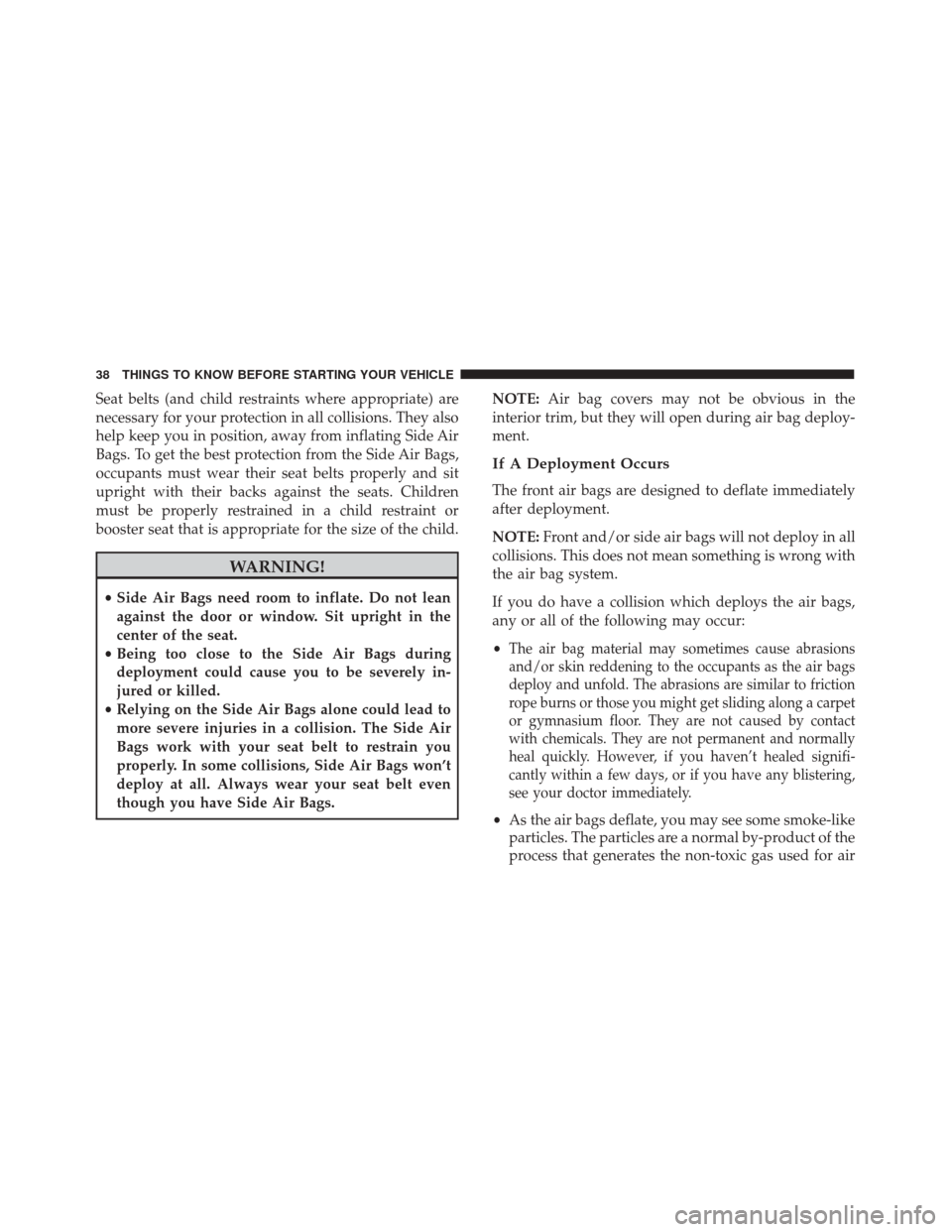
Seat belts (and child restraints where appropriate) are
necessary for your protection in all collisions. They also
help keep you in position, away from inflating Side Air
Bags. To get the best protection from the Side Air Bags,
occupants must wear their seat belts properly and sit
upright with their backs against the seats. Children
must be properly restrained in a child restraint or
booster seat that is appropriate for the size of the child.
WARNING!
•Side Air Bags need room to inflate. Do not lean
against the door or window. Sit upright in the
center of the seat.
• Being too close to the Side Air Bags during
deployment could cause you to be severely in-
jured or killed.
• Relying on the Side Air Bags alone could lead to
more severe injuries in a collision. The Side Air
Bags work with your seat belt to restrain you
properly. In some collisions, Side Air Bags won’t
deploy at all. Always wear your seat belt even
though you have Side Air Bags. NOTE:
Air bag covers may not be obvious in the
interior trim, but they will open during air bag deploy-
ment.
If A Deployment Occurs
The front air bags are designed to deflate immediately
after deployment.
NOTE: Front and/or side air bags will not deploy in all
collisions. This does not mean something is wrong with
the air bag system.
If you do have a collision which deploys the air bags,
any or all of the following may occur:
•
The air bag material may sometimes cause abrasions
and/or skin reddening to the occupants as the air bags
deploy and unfold. The abrasions are similar to friction
rope burns or those you might get sliding along a carpet
or gymnasium floor. They are not caused by contact
with chemicals. They are not permanent and normally
heal quickly. However, if you haven’t healed signifi-
cantly within a few days, or if you have any blistering,
see your doctor immediately.
• As the air bags deflate, you may see some smoke-like
particles. The particles are a normal by-product of the
process that generates the non-toxic gas used for air
38 THINGS TO KNOW BEFORE STARTING YOUR VEHICLE
Page 46 of 338
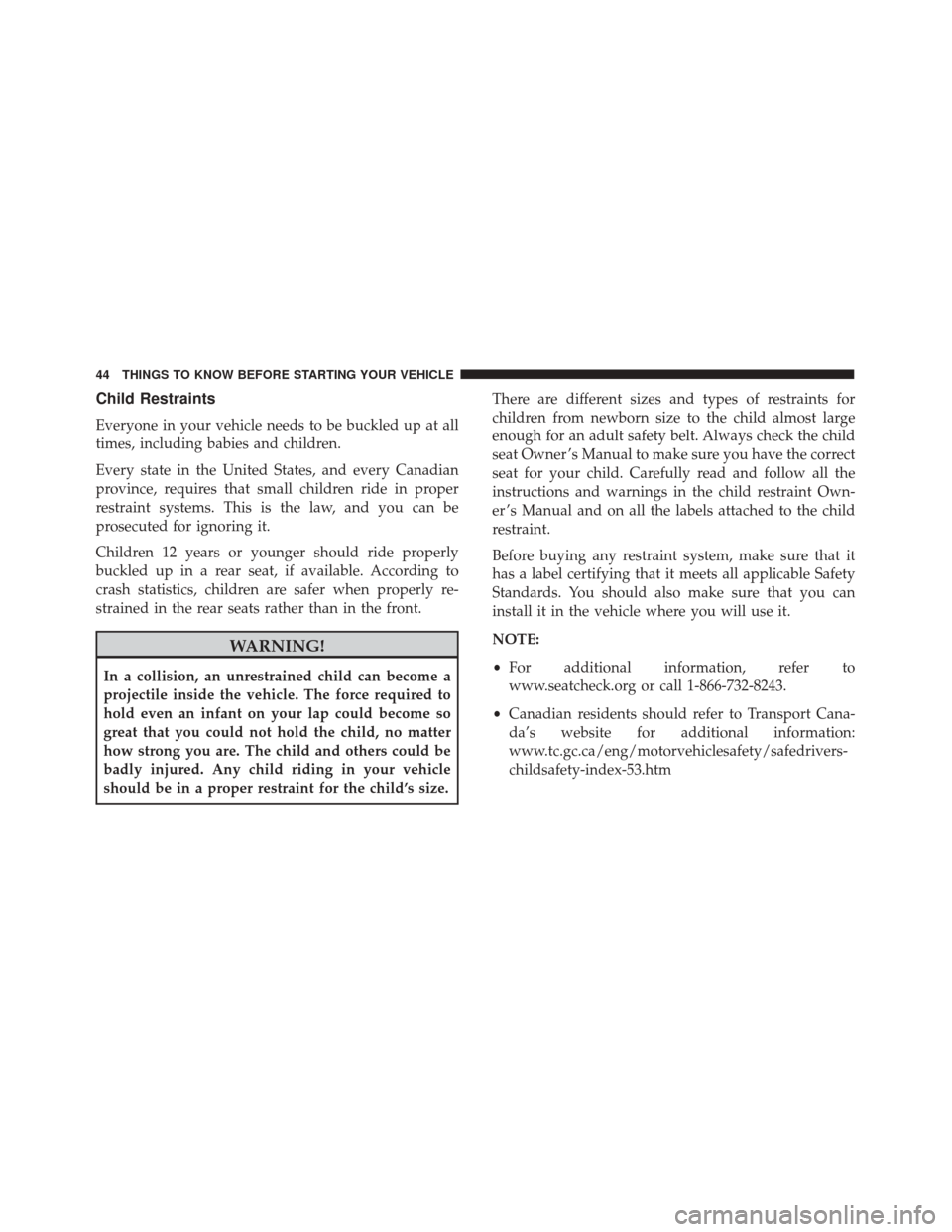
Child Restraints
Everyone in your vehicle needs to be buckled up at all
times, including babies and children.
Every state in the United States, and every Canadian
province, requires that small children ride in proper
restraint systems. This is the law, and you can be
prosecuted for ignoring it.
Children 12 years or younger should ride properly
buckled up in a rear seat, if available. According to
crash statistics, children are safer when properly re-
strained in the rear seats rather than in the front.
WARNING!
In a collision, an unrestrained child can become a
projectile inside the vehicle. The force required to
hold even an infant on your lap could become so
great that you could not hold the child, no matter
how strong you are. The child and others could be
badly injured. Any child riding in your vehicle
should be in a proper restraint for the child’s size.There are different sizes and types of restraints for
children from newborn size to the child almost large
enough for an adult safety belt. Always check the child
seat Owner ’s Manual to make sure you have the correct
seat for your child. Carefully read and follow all the
instructions and warnings in the child restraint Own-
er ’s Manual and on all the labels attached to the child
restraint.
Before buying any restraint system, make sure that it
has a label certifying that it meets all applicable Safety
Standards. You should also make sure that you can
install it in the vehicle where you will use it.
NOTE:
•
For additional information, refer to
www.seatcheck.org or call 1-866-732-8243.
• Canadian residents should refer to Transport Cana-
da’s website for additional information:
www.tc.gc.ca/eng/motorvehiclesafety/safedrivers-
childsafety-index-53.htm
44 THINGS TO KNOW BEFORE STARTING YOUR VEHICLE
Page 47 of 338
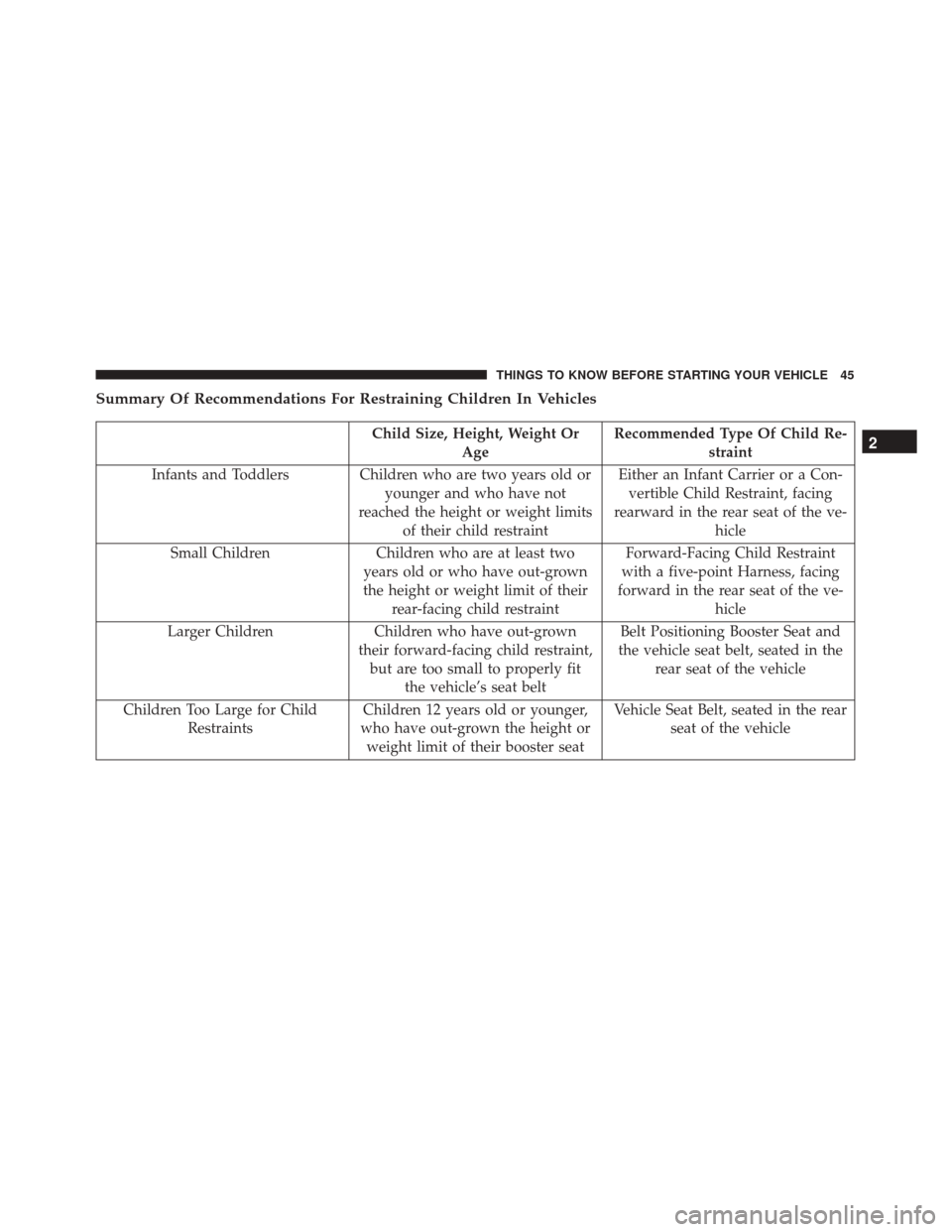
Summary Of Recommendations For Restraining Children In Vehicles
Child Size, Height, Weight OrAge Recommended Type Of Child Re-
straint
Infants and Toddlers Children who are two years old or younger and who have not
reached the height or weight limits of their child restraint Either an Infant Carrier or a Con-
vertible Child Restraint, facing
rearward in the rear seat of the ve- hicle
Small Children Children who are at least two years old or who have out-grown
the height or weight limit of their rear-facing child restraint Forward-Facing Child Restraint
with a five-point Harness, facing
forward in the rear seat of the ve- hicle
Larger Children Children who have out-grown
their forward-facing child restraint, but are too small to properly fit the vehicle’s seat belt Belt Positioning Booster Seat and
the vehicle seat belt, seated in the rear seat of the vehicle
Children Too Large for Child Restraints Children 12 years old or younger,
who have out-grown the height or weight limit of their booster seat Vehicle Seat Belt, seated in the rear
seat of the vehicle2
THINGS TO KNOW BEFORE STARTING YOUR VEHICLE 45
Page 48 of 338
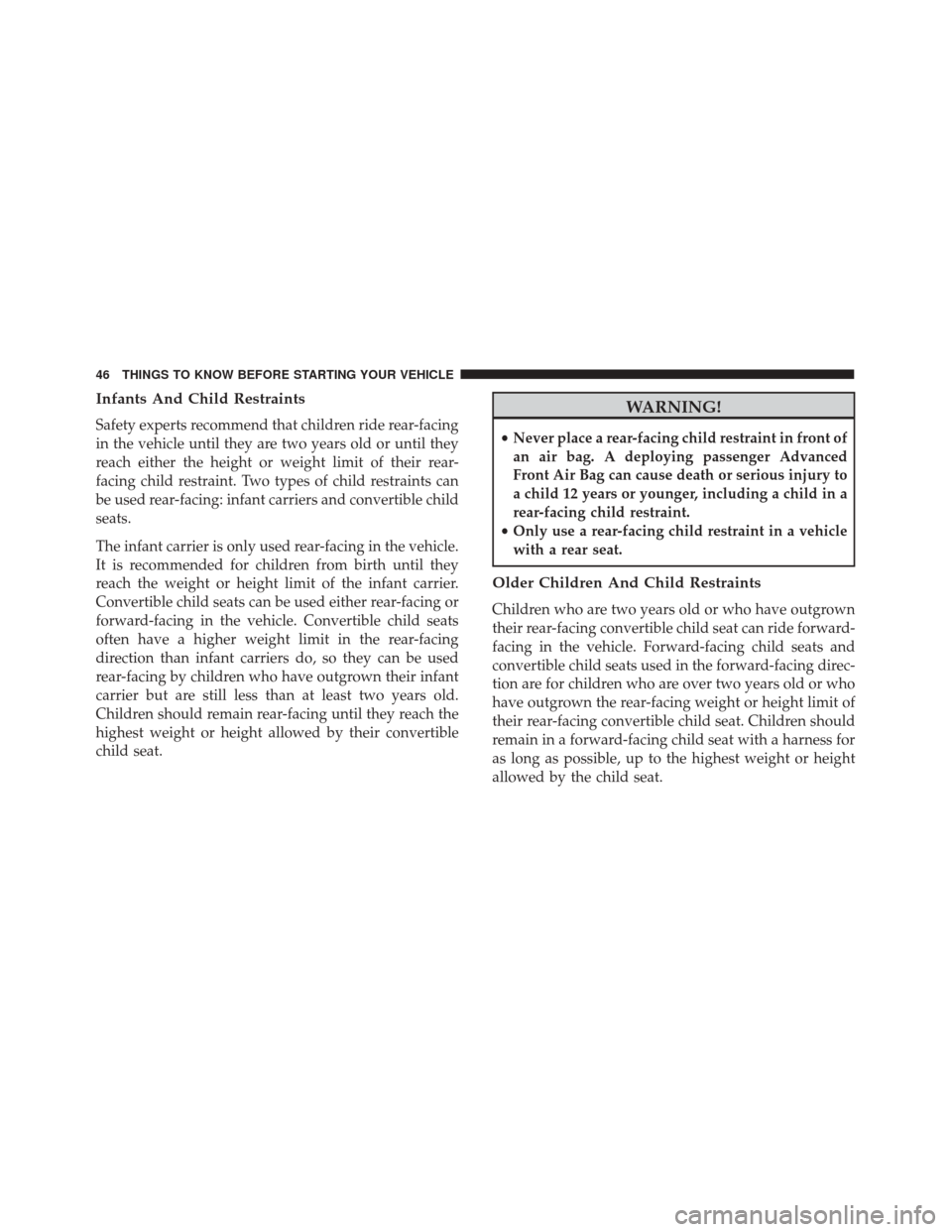
Infants And Child Restraints
Safety experts recommend that children ride rear-facing
in the vehicle until they are two years old or until they
reach either the height or weight limit of their rear-
facing child restraint. Two types of child restraints can
be used rear-facing: infant carriers and convertible child
seats.
The infant carrier is only used rear-facing in the vehicle.
It is recommended for children from birth until they
reach the weight or height limit of the infant carrier.
Convertible child seats can be used either rear-facing or
forward-facing in the vehicle. Convertible child seats
often have a higher weight limit in the rear-facing
direction than infant carriers do, so they can be used
rear-facing by children who have outgrown their infant
carrier but are still less than at least two years old.
Children should remain rear-facing until they reach the
highest weight or height allowed by their convertible
child seat.
WARNING!
•Never place a rear-facing child restraint in front of
an air bag. A deploying passenger Advanced
Front Air Bag can cause death or serious injury to
a child 12 years or younger, including a child in a
rear-facing child restraint.
• Only use a rear-facing child restraint in a vehicle
with a rear seat.
Older Children And Child Restraints
Children who are two years old or who have outgrown
their rear-facing convertible child seat can ride forward-
facing in the vehicle. Forward-facing child seats and
convertible child seats used in the forward-facing direc-
tion are for children who are over two years old or who
have outgrown the rear-facing weight or height limit of
their rear-facing convertible child seat. Children should
remain in a forward-facing child seat with a harness for
as long as possible, up to the highest weight or height
allowed by the child seat.
46 THINGS TO KNOW BEFORE STARTING YOUR VEHICLE